Estimating Chlorophyll-a Concentrations in Optically Shallow Waters Using Gaofen-1 Wide-Field-of-View (GF-1 WFV) Datasets from Lake Taihu, China
Abstract
1. Introduction
2. Datasets and Methods
2.1. Datasets
2.1.1. Water Quality Parameters
2.1.2. Measurements of IOPs
- (1)
- Absorption Coefficients
- (2)
- Backscattering Coefficients
2.1.3. AOP Measurements
- (1)
- Underwater Irradiance Measurements
- (2)
- Above-Water Spectral Reflectance Measurements
2.1.4. GF-1 WFV Data
2.2. Methodology
2.2.1. Identifying the Emergent Aquatic Plants/Submerged Aquatic Plants
2.2.2. Water Depth-Optimized Bottom Effect Removal Method
2.2.3. Spectral Matching-Based Chlorophyll-a Retrieval Method
2.2.4. Accuracy Assessment Metrics
3. Results
3.1. In Situ Chlorophyll-a Concentrations
3.2. Identification of Emergent Aquatic Plants and Submerged Aquatic Plants
3.3. Upwelling and Downwelling Diffuse Attenuation Coefficients
3.4. Performance of the Spectral Reflectance Model with the Bottom Effect Removed
3.4.1. Spectral Library for Taihu Lake
3.4.2. Water Depth-Optimized Bottom Effect Removal
3.4.3. Chlorophyll-a Retrieval in Taihu Lake
Validation
4. Discussion
5. Conclusions
- (1)
- A method based on the NDVI can categorize the underwater land cover types into three categories: underwater aquatic plants (−0.46 ≤ NDVI < 0.52), emergent aquatic plants or floating-leaved plants (NDVI ≥ 0.52), and the bottom mud (NDVI < −0.46). Through visual inspection and field verification, the accuracy of the results is greater than 90%;
- (2)
- The characteristics of the downwelling and upwelling irradiance attenuation coefficients were discussed. The remote sensing-based retrieval models for the downwelling irradiance attenuation coefficients in the three visible bands yielded the following results. The RMSE values for the blue, green, and red bands were 3.13 , 2.07 , and 1.65 , respectively. The MAPE values for the blue, green, and red bands were 16.07%, 15.10%, and 13.85%, respectively. The upwelling irradiance attenuation coefficients () were 2.85 , 1.94 , and 1.53 , for the blue, green, and red bands, respectively, and the values for the blue, green, and red bands were 15.01%, 14.78%, and 13.60%, respectively. The values for the blue, green, and red bands were 0.46 , 0.28 , and 0.26 , respectively, and the values for the blue, green, and red bands were 13.50%, 12.08%, and 10.53%, respectively;
- (3)
- A chlorophyll-a concentration estimation algorithm based on the bottom effect removal method using a water depth optimization approach is proposed, yielding a MAPE of ±19.58% and RMSE of 8.69 . These values are superior to those of the traditional algorithm without bottom effect removal with a MAPE of ±245.12% and RMSE of 45.61 . The validation yields an accuracy of ±17.52% for MAPE and 10.89 for RMSE, which is consistent with the proposed algorithm.
Author Contributions
Funding
Institutional Review Board Statement
Informed Consent Statement
Data Availability Statement
Acknowledgments
Conflicts of Interest
References
- Ogashawara, I.; Mishra, D.R.; Gitelson, A.A. Remote Sensing of Inland Waters: Background and Current State-of-the-Art. In Bio-Optical Modeling and Remote Sensing of Inland Waters; Elsevier: Amsterdam, The Netherlands, 2017; pp. 1–24. ISBN 978-0-12-804654-8. [Google Scholar]
- Lehmann, M.K.; Gurlin, D.; Pahlevan, N.; Alikas, K.; Anstee, J.; Balasubramanian, S.V.; Barbosa, C.C.F.; Binding, C.; Bracher, A.; Bresciani, M.; et al. GLORIA-A Globally Representative Hyperspectral in Situ Dataset for Optical Sensing of Water Quality. Sci. Data. 2023, 10, 100. [Google Scholar] [CrossRef] [PubMed]
- Carder, K.; Lee, Z.; Chen, R.; Davis, C. Unmixing of Spectral Components Affecting Aviris Imagery of Tampa Bay. In Imaging Spectrometry of the Terrestrial Environment; Vane, G., Ed.; SPIE: Bellingham, WA, USA, 1993; Volume 1937, pp. 77–90. [Google Scholar]
- Maritorena, S.; Morel, A.; Gentili, B. Diffuse reflectance of oceanic shallow waters: Influence of Water Depth and Bottom Albedo. Limnol. Oceanogr. 1994, 39, 1689–1703. [Google Scholar] [CrossRef]
- Lodhi, M.; Rundquist, D. A Spectral Analysis of Bottom-Induced Variation in the Colour of Sand Hills Lakes, Nebraska, USA. Int. J. Remote Sens. 2001, 22, 1665–1682. [Google Scholar] [CrossRef]
- Gordon, H.; Clark, D.; Brown, J.; Brown, O.; Evans, R.; Broenkow, W. Phytoplankton Pigment Concentrations in the Middle Atlantic Bight -Comparison of Ship Determinations and Czcs Estimates. Appl. Opt. 1983, 22, 20–36. [Google Scholar] [CrossRef] [PubMed]
- O’Reilly, J.; Maritorena, S.; Mitchell, B.; Siegel, D.; Carder, K.; Garver, S.; Kahru, M.; McClain, C. Ocean Color Chlorophyll Algorithms for SeaWiFS. J. Geophys. Res. Oceans 1998, 103, 24937–24953. [Google Scholar] [CrossRef]
- O’Reilly, J.E.; Werdell, P.J. Chlorophyll Algorithms for Ocean Color Sensors-OC4, OC5 & OC6. Remote Sens. Environ. 2019, 229, 32–47. [Google Scholar] [CrossRef]
- Carder, K.L.; Chen, F.R.; Lee, Z.; Hawes, S.K.; Cannizzaro, J.P. MODIS Ocean Science Team Algorithm Theoretical Basis Document. ATBD 2003, 19, 7–18. [Google Scholar]
- Merder, J.; Zhao, G.; Pahlevan, N.; Rigby, R.A.; Stasinopoulos, D.M.; Michalak, A.M. A Novel Algorithm for Ocean Chlorophyll-a Concentration Using MODIS Aqua Data. ISPRS J. Photogramm. Remote Sens. 2024, 210, 198–211. [Google Scholar] [CrossRef]
- Song, Y.; Song, X.; Jiang, H.; Guo, Z.; Guo, Q. Quantitative Remote Sensing Retrieval for Algae in Inland Waters. Spectrosc. Spectr. Anal. 2010, 30, 1075–1079. [Google Scholar] [CrossRef]
- Yin, Z.; Li, J.; Zhang, B.; Liu, Y.; Yan, K.; Gao, M.; Xie, Y.; Zhang, F.; Wang, S. Increase in Chlorophyll-a Concentration in Lake Taihu from 1984 to 2021 Based on Landsat Observations. Sci. Total Environ. 2023, 873, 162168. [Google Scholar] [CrossRef]
- Gilerson, A.A.; Gitelson, A.A.; Zhou, J.; Gurlin, D.; Moses, W.; Ioannou, I.; Ahmed, S.A. Algorithms for Remote Estimation of Chlorophyll-a in Coastal and Inland Waters Using Red and near Infrared Bands. Opt. Express 2010, 18, 24109–24125. [Google Scholar] [CrossRef] [PubMed]
- Moses, W.J.; Gitelson, A.A.; Berdnikov, S.; Saprygin, V.; Povazhnyi, V. Operational MERIS-Based NIR-Red Algorithms for Estimating Chlorophyll-a Concentrations in Coastal Waters—The Azov Sea Case Study. Remote Sens. Environ. 2012, 121, 118–124. [Google Scholar] [CrossRef]
- Lu, H.; Huang, J.; Li, Y. Quantitative Retrieval of Chlorophyll-a by Remote Sensing Based on TM Data in Lake Taihu. In Optical and Digital Image Processing; Schelkens, P., Ebrahimi, T., Cristobal, G., Truchetet, F., Eds.; SPIE: Bellingham, WA, USA, 2008; Volume 7000. [Google Scholar]
- Zhao, X.; Xu, H.; Ding, Z.; Wang, D.; Deng, Z.; Wang, Y.; Wu, T.; Li, W.; Lu, Z.; Wang, G. Comparing Deep Learning with Several Typical Methods in Prediction of Assessing Chlorophyll-a by Remote Sensing: A Case Study in Taihu Lake, China. Water Supply 2021, 21, 3710–3724. [Google Scholar] [CrossRef]
- Doerffer, R.; Schiller, H. The MERIS Case 2 Water Algorithm. Int. J. Remote Sens. 2007, 28, 517–535. [Google Scholar] [CrossRef]
- Zimba, P.V.; Gitelson, A. Remote Estimation of Chlorophyll Concentration in Hyper-Eutrophic Aquatic Systems: Model Tuning and Accuracy Optimization. Aquaculture 2006, 256, 272–286. [Google Scholar] [CrossRef]
- Zhang, Y.; Liu, M.; Qin, B.; van der Woerd, H.J.; Li, J.; Li, Y. Modeling Remote-Sensing Reflectance and Retrieving Chlorphyll-a Concentration in Extremely Turbid Case-2 Waters (Lake Taihu, China). IEEE Trans. Geosci. Remote Sens. 2009, 47, 1937–1948. [Google Scholar] [CrossRef]
- Xu, J.; Zhang, B.; Song, K.; Wang, Z.; Liu, D.; Duan, H. Estimation of Chlorophyll-a Concentration in Lake Xinmiao Based on a Semi-Analytical Model. J. Infrared Millim. Waves 2008, 27, 197–201. [Google Scholar] [CrossRef]
- Spyrakos, E.; O’Donnell, R.; Hunter, P.D.; Miller, C.; Scott, M.; Simis, S.G.H.; Neil, C.; Barbosa, C.C.F.; Binding, C.E.; Bradt, S.; et al. Optical Types of Inland and Coastal Waters. Limnol. Oceanogr 2018, 63, 846–870. [Google Scholar] [CrossRef]
- Neil, C.; Spyrakos, E.; Hunter, P.D.; Tyler, A.N. A Global Approach for Chlorophyll-a Retrieval across Optically Complex Inland Waters Based on Optical Water Types (Vol 229, Pg 159, 2019). Remote Sens. Environ. 2020, 246, 111837. [Google Scholar] [CrossRef]
- Werdell, P.J.; McKinna, L.I.W.; Boss, E.; Ackleson, S.G.; Craig, S.E.; Gregg, W.W.; Lee, Z.; Maritorena, S.; Roesler, C.S.; Rousseaux, C.S.; et al. An Overview of Approaches and Challenges for Retrieving Marine Inherent Optical Properties from Ocean Color Remote Sensing. Prog. Oceanogr. 2018, 160, 186–212. [Google Scholar] [CrossRef]
- Gould, R.; Arnone, R. Remote Sensing Estimates of Inherent Optical Properties in a Coastal Environment. Remote Sens. Environ. 1997, 61, 290–301. [Google Scholar] [CrossRef]
- Lee, Z.; Carder, K.; Mobley, C.; Steward, R.; Patch, J. Hyperspectral Remote Sensing for Shallow Waters. I. A Semianalytical Model. Appl. Opt. 1998, 37, 6329–6338. [Google Scholar] [CrossRef]
- Lee, Z.; Carder, K.; Mobley, C.; Steward, R.; Patch, J. Hyperspectral Remote Sensing for Shallow Waters: 2. Deriving Bottom Depths and Water Properties by Optimization. Appl. Opt. 1999, 38, 3831–3843. [Google Scholar] [CrossRef] [PubMed]
- Lee, Z.P.; Zhang, M.R.; Carder, K.L.; Hall, L.O. A Neural Network Approach to Deriving Optical Properties and Depths of Shallow Waters. In Proceedings, Ocean Optics XIV; Office of Naval Research: Washington, DC, USA, 1998. [Google Scholar]
- Lee, Z.; Carder, K. Effect of Spectral Band Numbers on the Retrieval of Water Column and Bottom Properties from Ocean Color Data. Appl. Opt. 2002, 41, 2191–2201. [Google Scholar] [CrossRef]
- Albert, A.; Mobley, C. An Analytical Model for Subsurface Irradiance and Remote Sensing Reflectance in Deep and Shallow Case-2 Waters. Opt. Express 2003, 11, 2873–2890. [Google Scholar] [CrossRef]
- Ma, R.; Duan, H.; Liu, Q.; Loiselle, S.A. Approximate Bottom Contribution to Remote Sensing Reflectance in Taihu Lake, China. J. Great Lakes Res. 2011, 37, 18–25. [Google Scholar] [CrossRef]
- Zhang, Y.; Duan, H.; Xi, H.; Huang, Z.; Tsou, J.; Jiang, T.; Liang, X.S. Evaluation of the Influence of Aquatic Plants and Lake Bottom on the Remote-Sensing Reflectance of Optically Shallow Waters. Atmos. Ocean 2018, 56, 277–288. [Google Scholar] [CrossRef]
- Shen, Q.; Wu, C.; Zhang, B.; Li, J. Retrieval of Chlorophyll-a and Suspended Matter Concentration in Water Supply Sources of Wuxi and Suzhou Using Multi-Spectral Remote Sensing Images. In Proceedings of the 2008 International Workshop on Earth Observation and Remote Sensing Applications, Beijing, China, 30 June–2 July 2008. [Google Scholar]
- Shi, K.; Li, Y.; Li, L.; Lu, H.; Song, K.; Liu, Z.; Xu, Y.; Li, Z. Remote Chlorophyll-a Estimates for Inland Waters Based on a Cluster-Based Classification. Sci. Total Environ. 2013, 444, 1–15. [Google Scholar] [CrossRef]
- Cao, Z.; Wang, M.; Ma, R.; Zhang, Y.; Duan, H.; Jiang, L.; Xue, K.; Xiong, J.; Hu, M. A Decade-Long Chlorophyll-a Data Record in Lakes across China from VIIRS Observations. Remote Sens. Environ. 2024, 301, 113953. [Google Scholar] [CrossRef]
- Yang, Y.; Hou, X.; Gao, W.; Li, F.; Guo, F.; Zhang, Y. Retrieving Lake Chla Concentration from Remote Sensing: Sampling Time Matters. Ecol. Indic. 2024, 158, 111290. [Google Scholar] [CrossRef]
- Zhang, Y.; Ma, R.; Duan, H.; Loiselle, S.A.; Xu, J.; Ma, M. A Novel Algorithm to Estimate Algal Bloom Coverage to Subpixel Resolution in Lake Taihu. IEEE J. Sel. Top. Appl. Earth Obs. Remote Sens. 2014, 7, 3060–3068. [Google Scholar] [CrossRef]
- Qi, L.; Hu, C.; Duan, H.; Zhang, Y.; Ma, R. Influence of Particle Composition on Remote Sensing Reflectance and MERIS Maximum Chlorophyll Index Algorithm: Examples from Taihu Lake and Chaohu Lake. IEEE Geosci. Remote Sens. Lett. 2015, 12, 1170–1174. [Google Scholar] [CrossRef]
- Pan, X.; Yuan, J.; Yang, Z.; Tansey, K.; Xie, W.; Song, H.; Wu, Y.; Yang, Y. Spatio-Temporal Variation of Cyanobacteria Blooms in Taihu Lake Using Multiple Remote Sensing Indices and Machine Learning. Remote Sens. 2024, 16, 889. [Google Scholar] [CrossRef]
- Mueller, J.L.; Morel, A.; Frouin, R.; Davis, C.; Arnone, R.; Carder, K.; Lee, Z.P.; Steward, R.G.; Hooker, S.; Mobley, C.D.; et al. Ocean Optics Protocols for Satellite Ocean Color Sensor Validation, Revision 5, Volume V: Biogeochemical and Bio-Optical Measurements and Data Analysis Protocols. Washington, D.C.: NASA, 2003. Available online: https://oceancolor.gsfc.nasa.gov/resources/docs/technical/protocols_ver5_volv.pdf (accessed on 15 October 2024).
- Mueller, J.L.; Morel, A.; Frouin, R.; Davis, C.; Arnone, R.; Carder, K.; Lee, Z.P.; Steward, R.G.; Hooker, S.; Mobley, C.D.; et al. Ocean Optics Protocols for Satellite Ocean Color Sensor Validation, Revision 4, Volume IV: Inherent Optical Properties: Instruments, Characterizations, Field Measurements and Data Analysis Protocols. Washington, D.C.: NASA, 2003. Available online: https://oceancolor.gsfc.nasa.gov/resources/docs/technical/protocols_ver4_voliv.pdf (accessed on 15 October 2024).
- Gordon, H.; Brown, O.; Evans, R.; Brown, J.; Smith, R.; Baker, K.; Clark, D. A semianalytic radiance model of ocean color. J. Geophys. Res. 1988, 93, 10909–10924. [Google Scholar] [CrossRef]
- Bricaud, A.; Babin, M.; Morel, A.; Claustre, H. Variability in the chlorophyll-specific absorption coefficients of natural phytoplankton: Analysis and parameterization. J. Geophys. Res. 1995, 100, 13321–13332. [Google Scholar] [CrossRef]
- Deng, R.; He, Y.; Qin, Y.; Chen, Q.; Chen, L. Measuring Pure Water Absorption Coefficient in the Near-Infrared Spectrum (900-2500 Nm). Natl. Remote Sens. Bull. 2012, 16, 192–206. [Google Scholar] [CrossRef]
- Smith, R.; Baker, K. Optical-Properties of the Clearest Natural-Waters (200–800 Nm). Appl. Opt. 1981, 20, 177–184. [Google Scholar] [CrossRef]
- Hoogenboom, H.J.; Dekker, A.J.; Haan, J.F. Retrieval of Chlorophyll and Suspended Matter from Imaging Spectrometry Data by Matrix Inversion. Can. J. Remote Sens 1998, 24, 144–152. [Google Scholar] [CrossRef]
- Jones, D.; Wills, M. The attenuation of light in sea and estuarine waters in relation to the concen—Tration of suspended solid matter. J. Mar. Biol. Assoc. UK 1956, 35, 431–444. [Google Scholar] [CrossRef]
- Ma, S.; Qian, Z. The Water Masses and the Suspended Matters Distributions of the South Yellow Sea and Its Optic Characteristics. Oceanol. Limnol. Sin. 1995, 26, 8–15. [Google Scholar]
- Zhang, Y.; Yang, D. Distribution, Seasonal Variation and Correlation Analysis of the Transparency in Taihu Lake. Trans. Oceanol. Limnol. 2003, 30–36. [Google Scholar] [CrossRef]
- Le, C.; Li, Y.; Cha, Y.; Sun, D.; Wang, L.; He, J. Optical Properties and Remote Sensing Retrieval Model of Diffuse Attenuation Coefficient of Taihu Lake Water Body. J. Appl. Ecol. 2009, 20, 337–343. [Google Scholar]
- Zhu, L.; Li, Y.; Zhao, S.; Guo, Y. Remote Sensing Monitoring of Taihu Lake Water Quality by Using GF-1 Satellite WFV Data. Remote Sens. Nat. Res. 2015, 27, 113–120. [Google Scholar]
- Forget, P.; Ouillon, S.; Lahet, F.; Broche, P. Inversion of re-flectance spectra of non-chlorophyllous turbid coastal waters. Remote Sens. Environ. 1999, 68, 264–272. [Google Scholar]
- Cannizzaro, J.; Carder, K. Estimating chlorophyll-a Concentrations from Remote-Sensing Reflectance in Optically Shallow Waters. Remote Sens. Environ. 2006, 101, 13–24. [Google Scholar] [CrossRef]
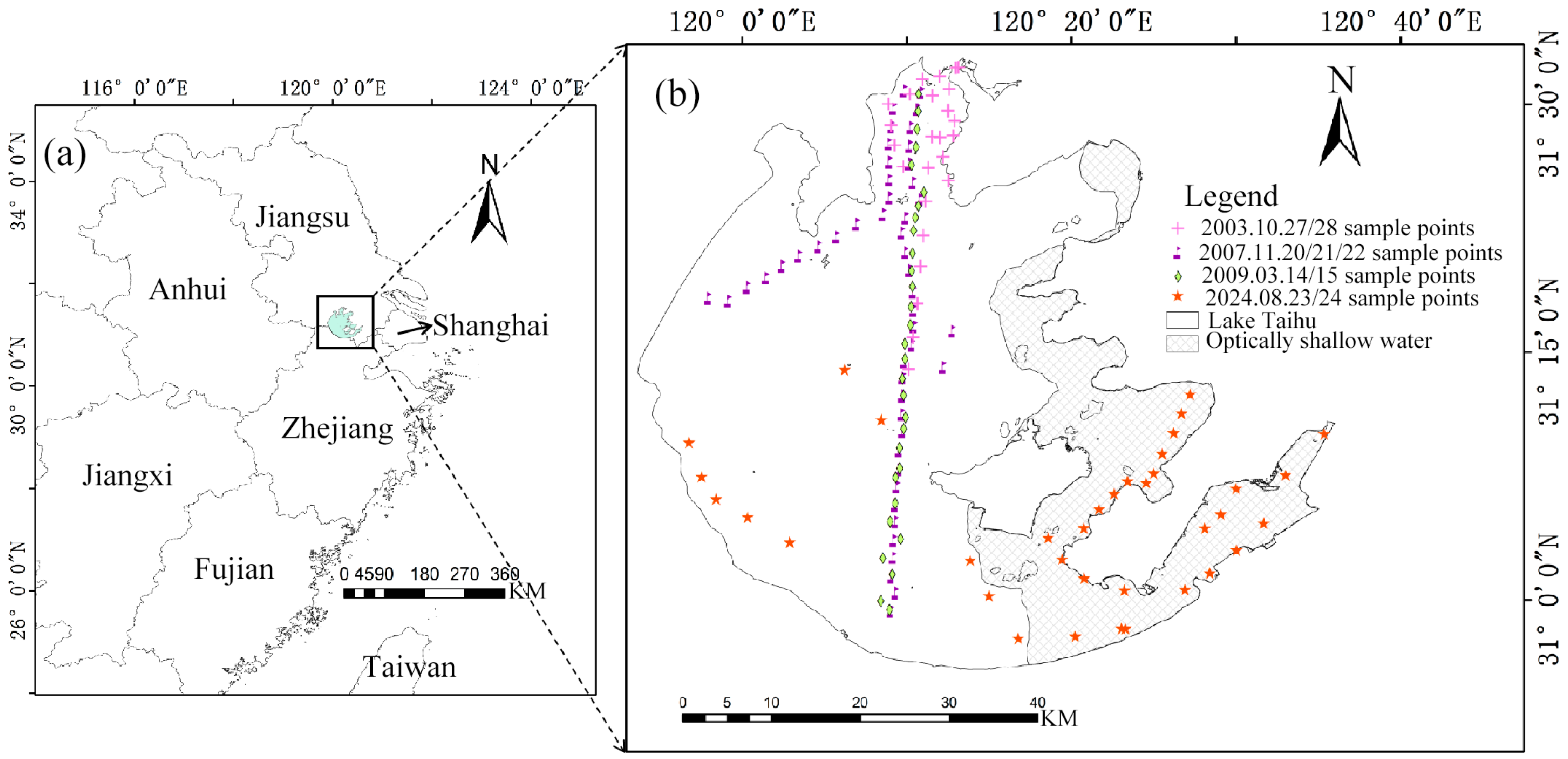
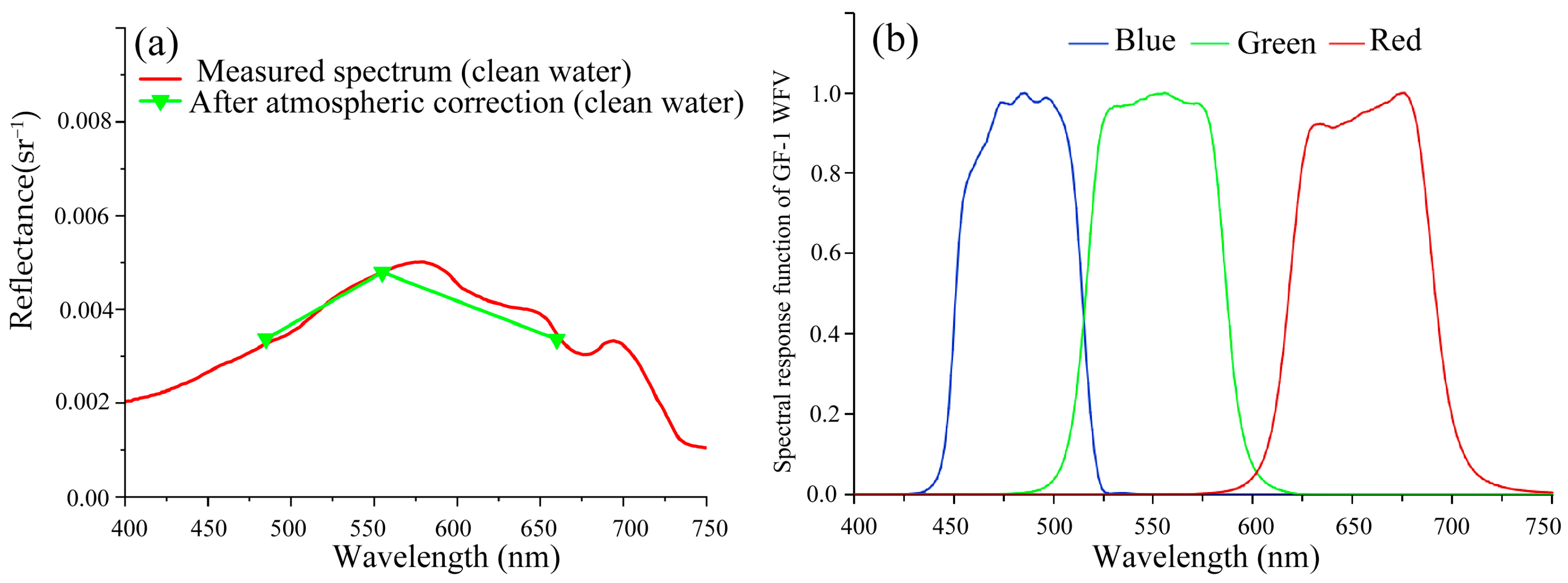
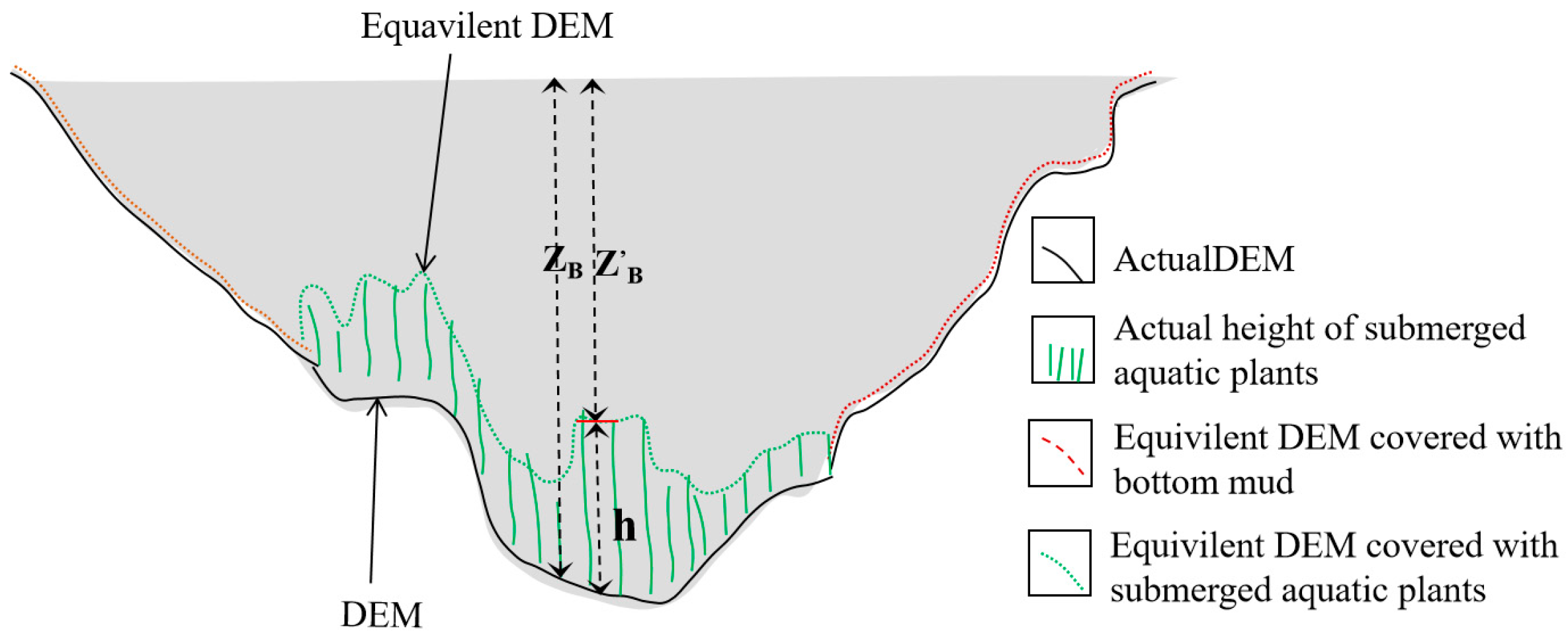
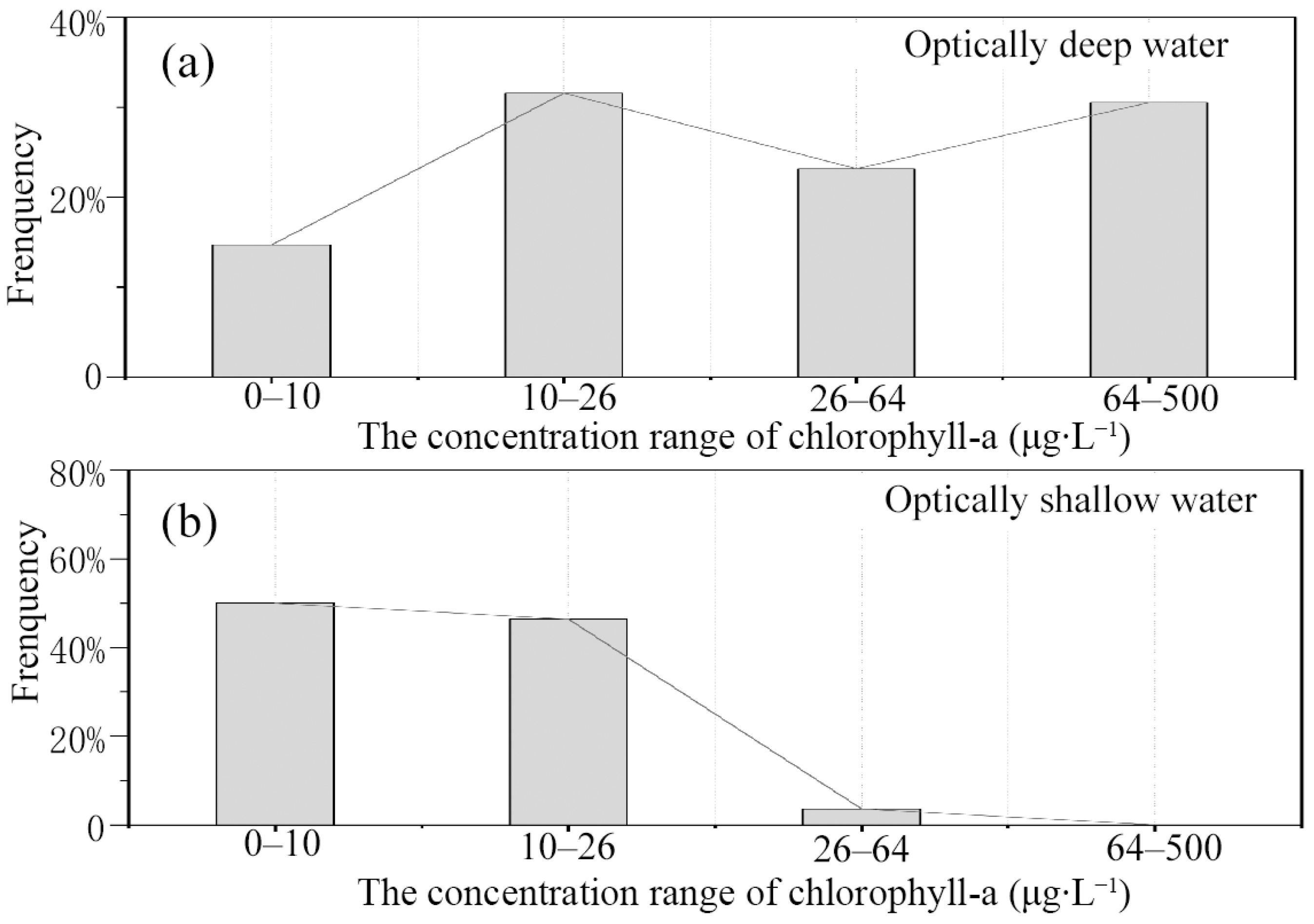
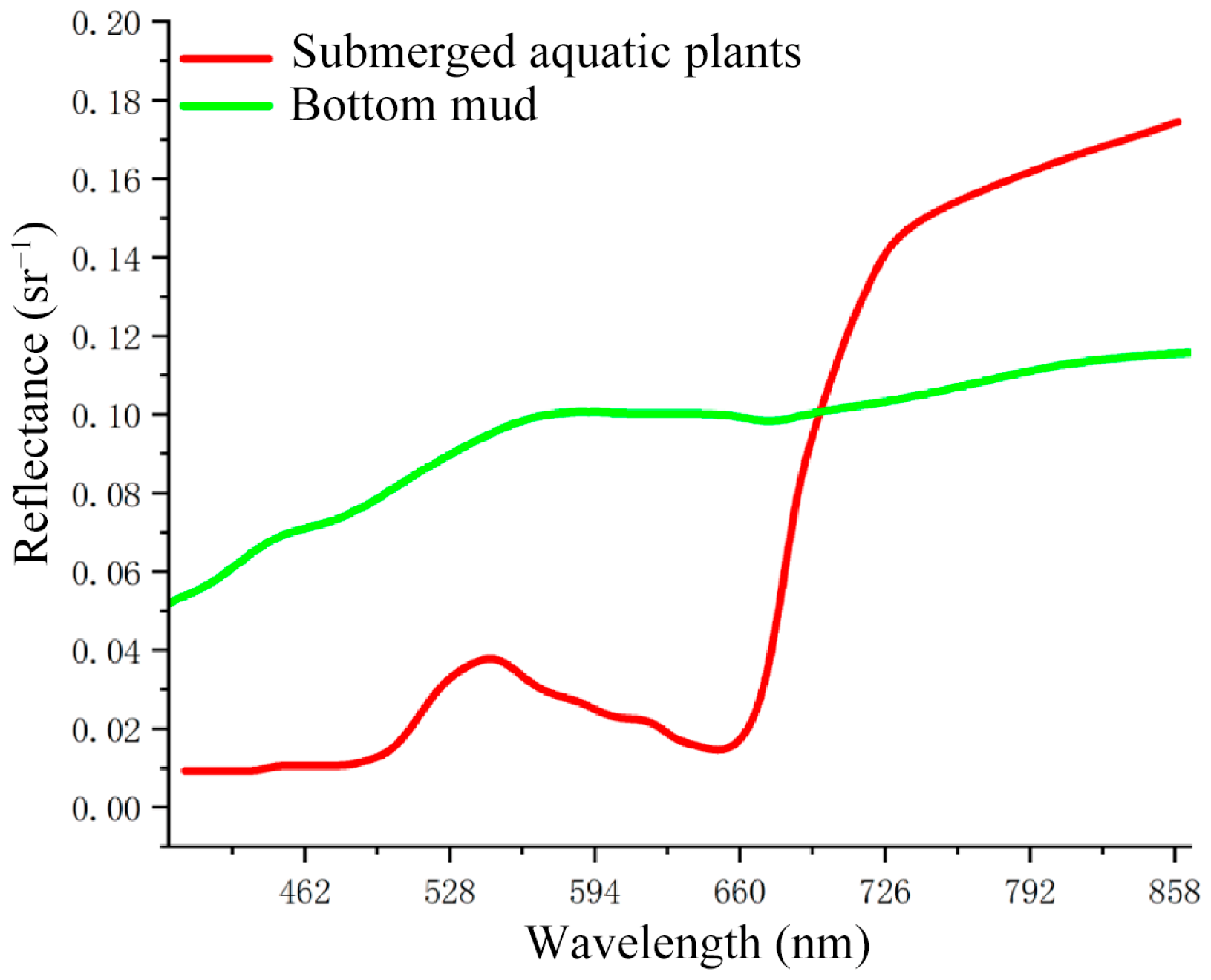
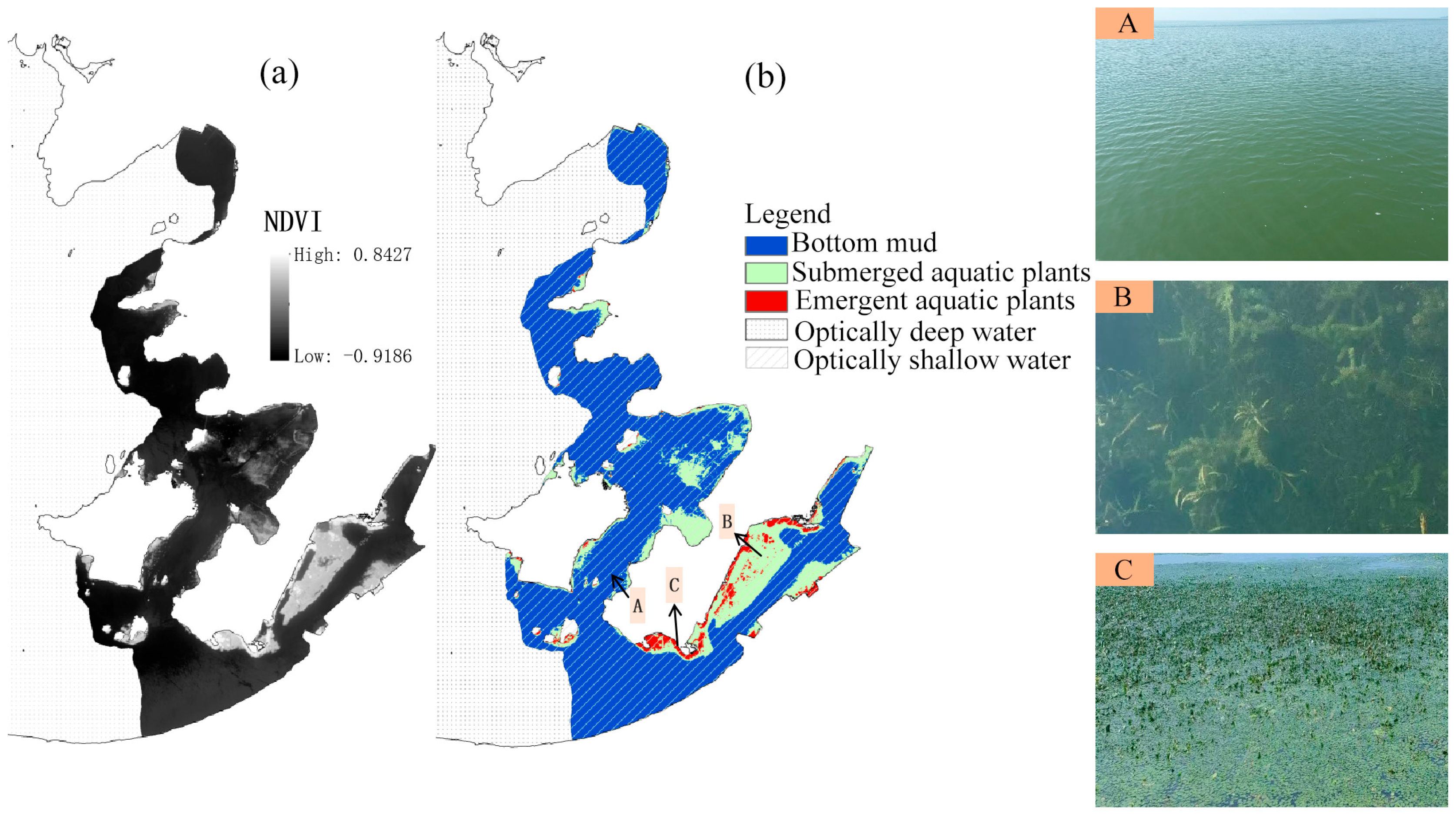
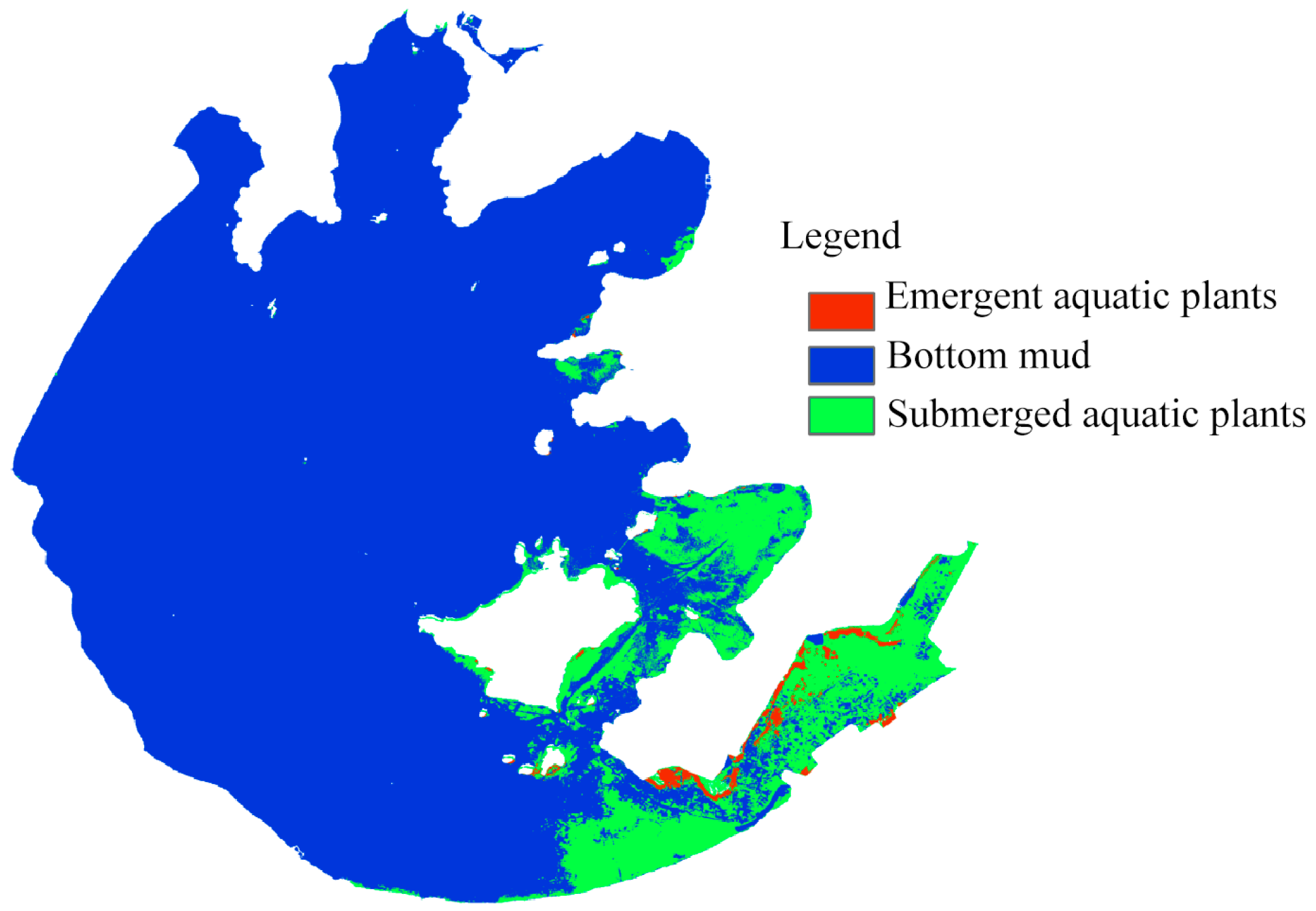
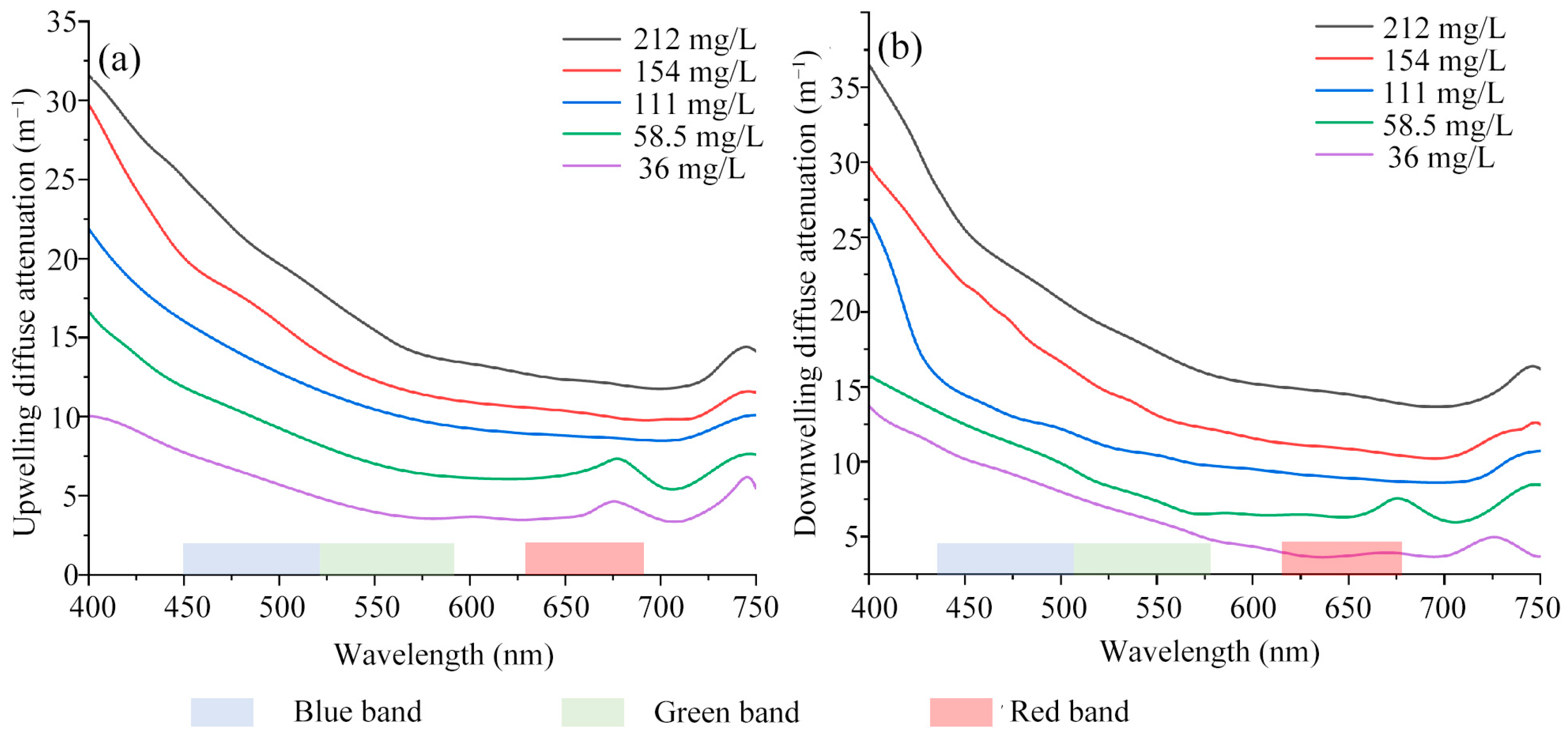
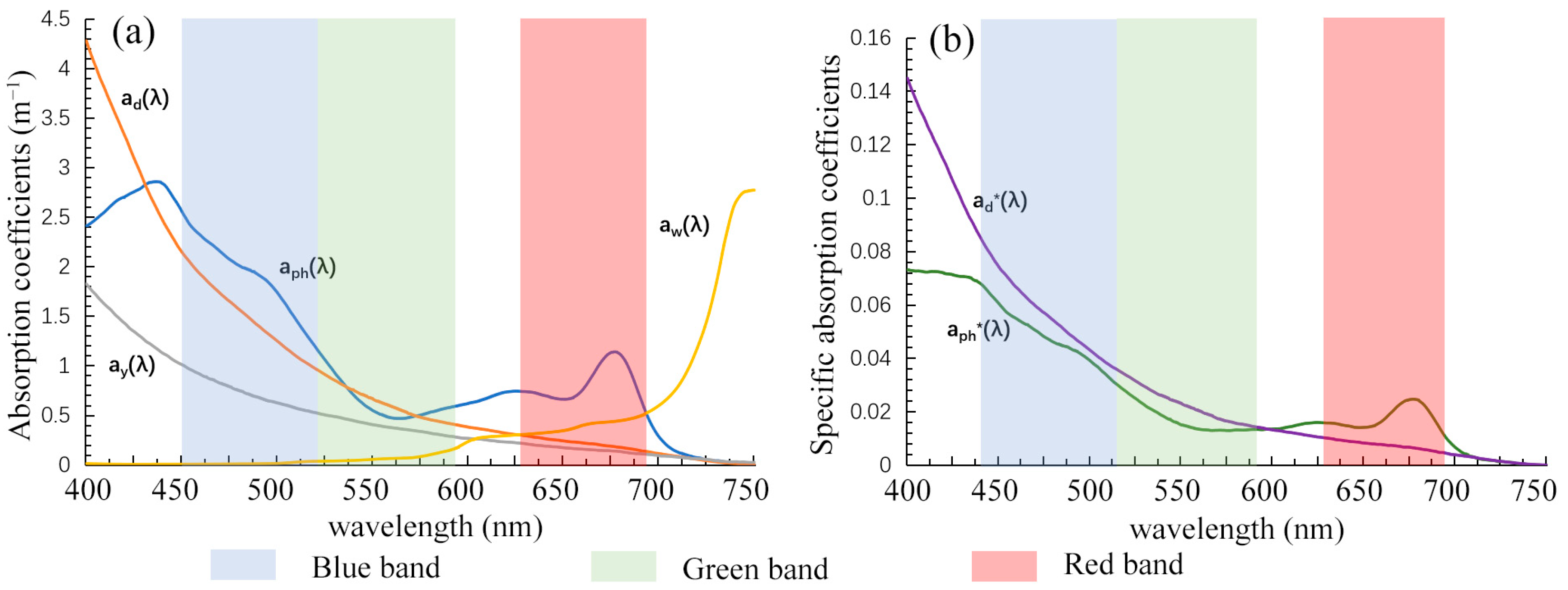

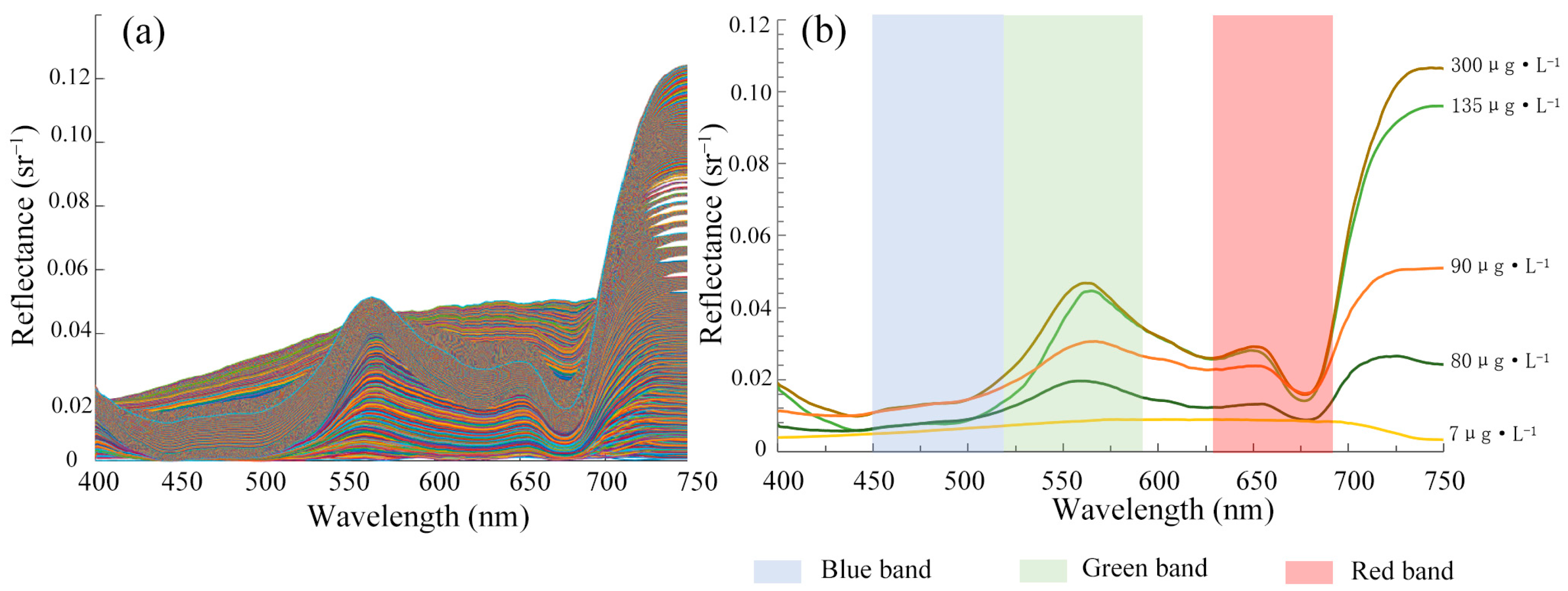
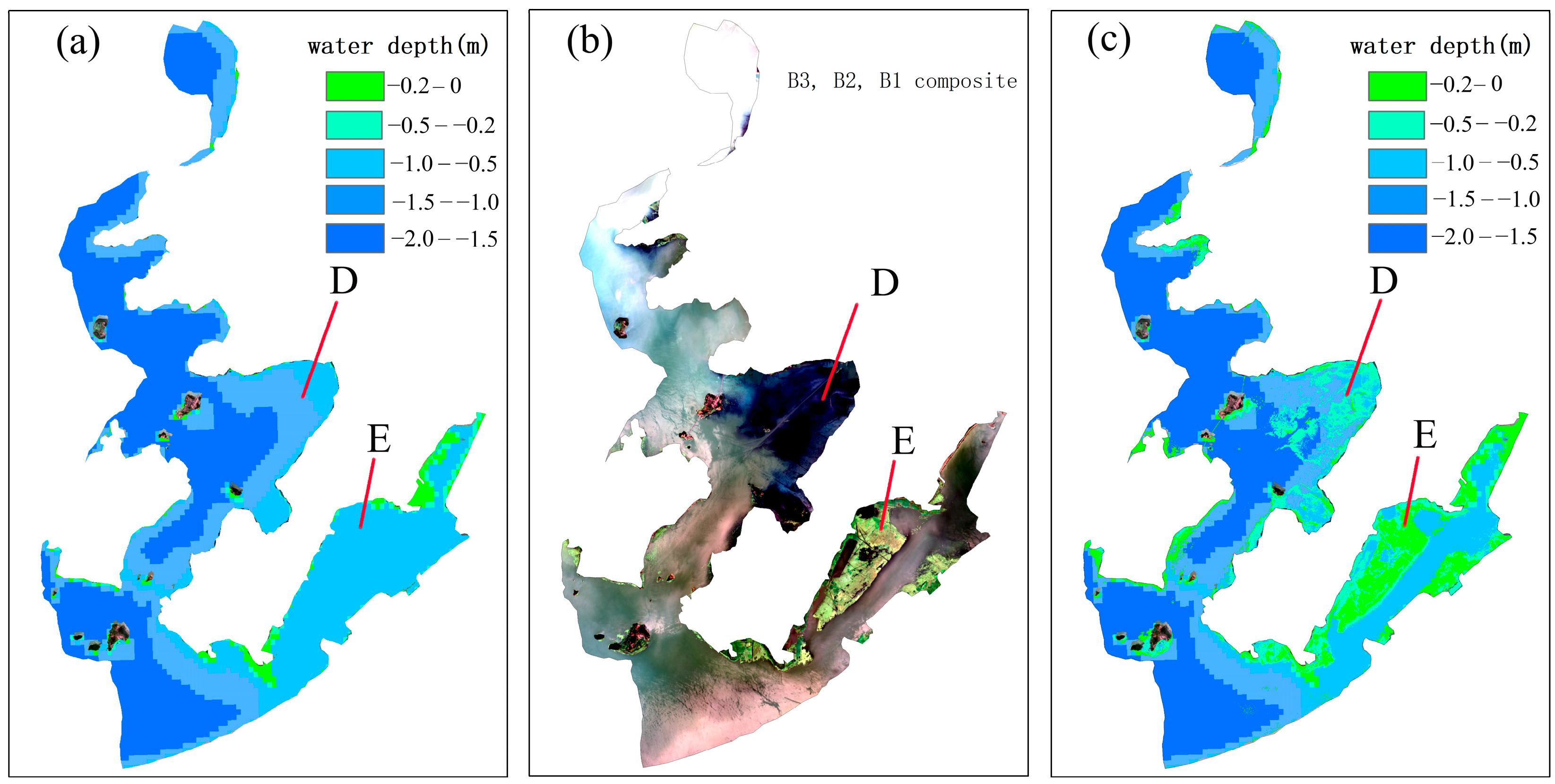

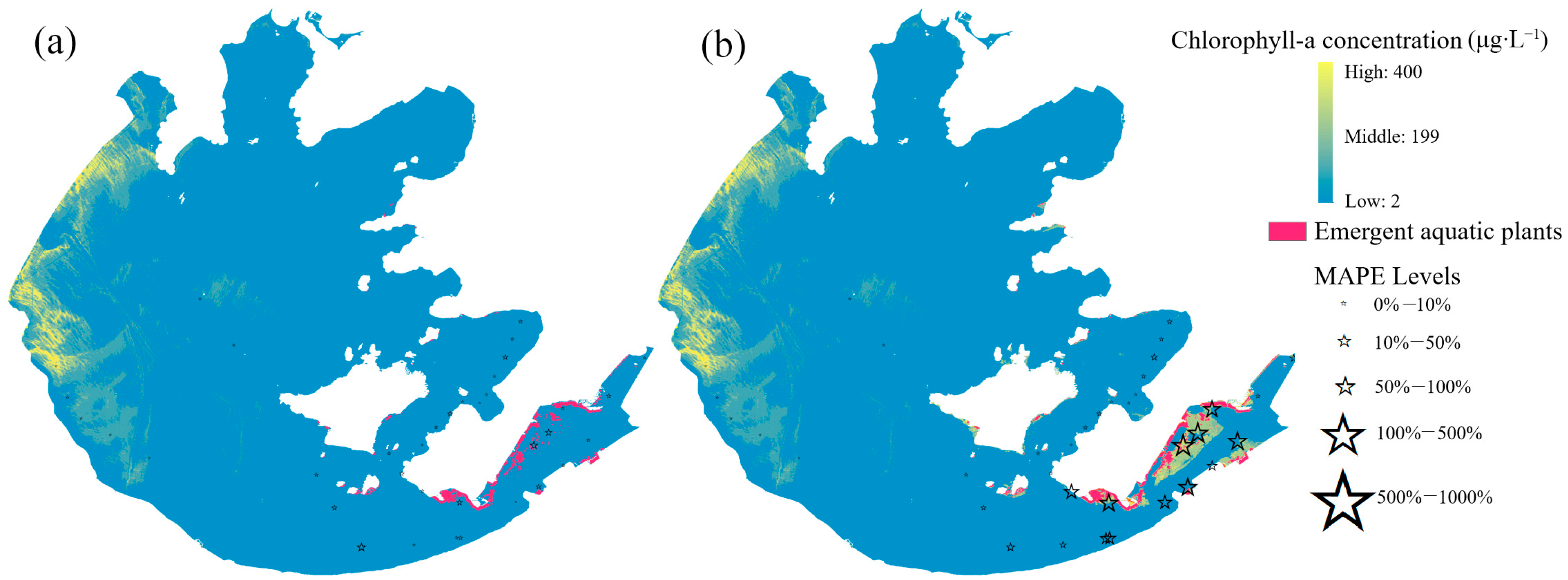
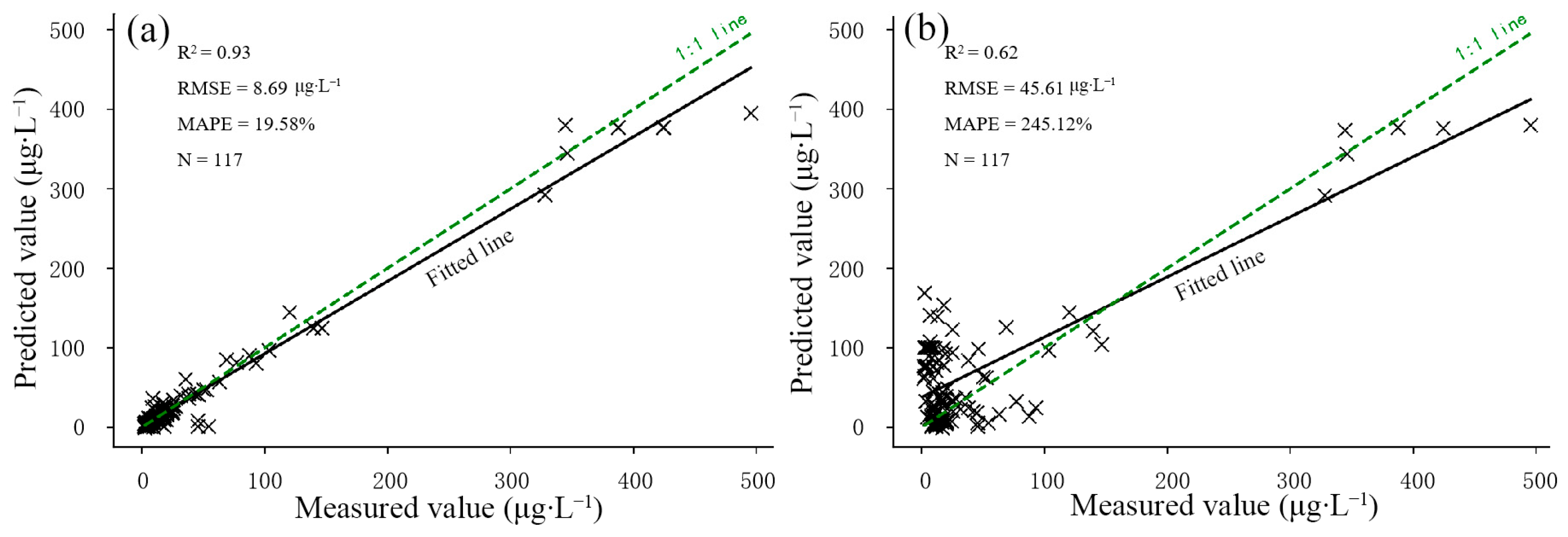
| Cruise | Location | Dates | Chlorophyll-a (μg · L−1) | |||
|---|---|---|---|---|---|---|
| Mean | Standard Deviation | Minimum | Maximum | |||
| HJ-2003 | Meiliang Bay | 27–28 October 2003 | 42.16 | 56.47 | 2.20 | 230.59 |
| KI-2007 | Meiliang Bay–West Lake Taihu | 20–22 November 2007 | 44.90 | 74.83 | 7.25 | 387.11 |
| MIPCAS-2009 | Meiliang Bay–Huzhou County | 14–15 March 2009 | 10.41 | 16.51 | 5.41 | 54.07 |
| NKRD-2024 | Eastern–Southwest Lake Taihu | 23–24 August 2024 | 62.77 | 123.88 | 2.00 | 495.00 |
| Classification | ||||
|---|---|---|---|---|
| Ground truth | Bottom Mud | Submerged Aquatic Plants | Emergent Plants | |
| Bottom mud | 6 | 0 | 0 | |
| Submerged aquatic plants | 0 | 13 | 1 | |
| Emergent aquatic plants | 0 | 0 | 6 | |
| Formula | RMSE (m−1) | MAPE | Formula | RMSE (m−1) | MAPE | Formula | RMSE (m−1) | MAPE | |
|---|---|---|---|---|---|---|---|---|---|
| Blue | = 0.078 × TSS + 3.717 | 3.13 | 16.07% | = 0.081 × TSS + 2.678 | 2.85 | 15.01% | = 0.084 × TSS + 3.938 | 0.46 | 13.50% |
| Green | = 0.059 × TSS + 2.226 | 2.07 | 15.10% | = 0.058 × TSS + 1.880 | 1.94 | 14.78% | = 0.062 × TSS + 1.972 | 0.28 | 12.08% |
| Red | = 0.046 × TSS + 2.474 | 1.65 | 13.85% | = 0.042 × TSS + 2.449 | 1.53 | 13.60% | = 0.04 × TSS + 3.546 | 0.26 | 10.53% |
| Chlorophyll-a | RMSE | MAPE |
|---|---|---|
| Obtained using the bottom effect removal method | 8.69 | 19.58% |
| Obtained without using the bottom effect removal method | 45.61 | 245.12% |
Disclaimer/Publisher’s Note: The statements, opinions and data contained in all publications are solely those of the individual author(s) and contributor(s) and not of MDPI and/or the editor(s). MDPI and/or the editor(s) disclaim responsibility for any injury to people or property resulting from any ideas, methods, instructions or products referred to in the content. |
© 2025 by the authors. Licensee MDPI, Basel, Switzerland. This article is an open access article distributed under the terms and conditions of the Creative Commons Attribution (CC BY) license (https://creativecommons.org/licenses/by/4.0/).
Share and Cite
Yan, F.; Li, Y.; Fan, X.; Jian, H.; Li, Y. Estimating Chlorophyll-a Concentrations in Optically Shallow Waters Using Gaofen-1 Wide-Field-of-View (GF-1 WFV) Datasets from Lake Taihu, China. Remote Sens. 2025, 17, 1299. https://doi.org/10.3390/rs17071299
Yan F, Li Y, Fan X, Jian H, Li Y. Estimating Chlorophyll-a Concentrations in Optically Shallow Waters Using Gaofen-1 Wide-Field-of-View (GF-1 WFV) Datasets from Lake Taihu, China. Remote Sensing. 2025; 17(7):1299. https://doi.org/10.3390/rs17071299
Chicago/Turabian StyleYan, Fuli, Yuzhuo Li, Xiangtao Fan, Hongdeng Jian, and Yun Li. 2025. "Estimating Chlorophyll-a Concentrations in Optically Shallow Waters Using Gaofen-1 Wide-Field-of-View (GF-1 WFV) Datasets from Lake Taihu, China" Remote Sensing 17, no. 7: 1299. https://doi.org/10.3390/rs17071299
APA StyleYan, F., Li, Y., Fan, X., Jian, H., & Li, Y. (2025). Estimating Chlorophyll-a Concentrations in Optically Shallow Waters Using Gaofen-1 Wide-Field-of-View (GF-1 WFV) Datasets from Lake Taihu, China. Remote Sensing, 17(7), 1299. https://doi.org/10.3390/rs17071299






